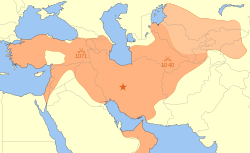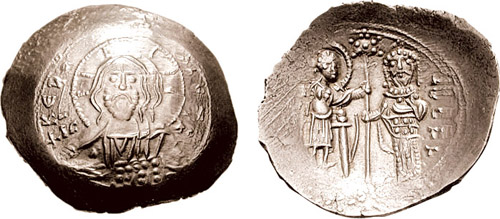Histamenon nomisma-Alexius I-sb1776
- +KE RO ALEZ', IC XC across field, facing bust of Christ, nimbate, raising hand in benediction, holding Gospels
- [DIMITI] to left, D EC PO TH T to right, Saint Demetrius, nimbate, standing right, presenting labarum to Alexius, wearing crown and loros, standing facing, each grasping labarum.
DOC IV 4; SB 1904.
According to DOC, this issue was the very brief first coinage of the Thessalonica mint, which Alexius opened as he passed through in September 1081 on his way to confront the invading Normans under Robert Guiscard. Hendy presumes this type was discontinued in 1082, when the significantly debased type with patriarchal cross replacing the labarum was introduced. However, since DOC IV was written numerous examples of this previously extremely rare type have come out of the Balkans, in fineness ranging from gold-colored electrum to nearly pure silver. Hendy notes an alternate chronology, with the labarum issue being struck during the entire span of the Norman incursion into Greece, through 1084, but dismisses this longer time span based on the sequence of types at Constantinople. Perhaps when the total number of extant specimens is tallied the militant labarum bearing type could be re-dated to the period of the Norman war, 1081-1084.
Coin from CNG coins, through Wildwinds.Relevante Bilder

















Relevante Artikel
HyperpyronDas Hyperpyron war eine seit der Münzreform von 1092 unter Kaiser Alexios I. Komnenos als Skyphat geprägte byzantinische Goldmünze, die die Nachfolge des Histamenon als Standardgoldmünze antrat. .. weiterlesen
SolidusDer Solidus oder Aureus Solidus war eine römisch-byzantinische Goldmünze. Er wurde vom Kaiser Konstantin dem Großen im Jahr 309 an Stelle des Aureus als neues Nominal eingeführt und blieb, ab dem 10. Jahrhundert als Histamenon und ab dem 11. Jahrhundert als Hyperpyron, bis zur Eroberung von Konstantinopel (1453) länger als ein Jahrtausend im Umlauf. Im 5. und 6. Jahrhundert kursierten viele Millionen Solidi im gesamten Mittelmeerraum und darüber hinaus. Der Solidus war bis zum beginnenden 12. Jahrhundert die „Leitwährung“ für ganz Europa und den gesamten Mittelmeerraum und wird auch als Euro des Mittelalters bezeichnet. Wörter wie Sold oder Soldat leiten sich vom Namen der Münze ab. .. weiterlesen
